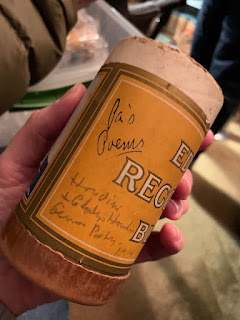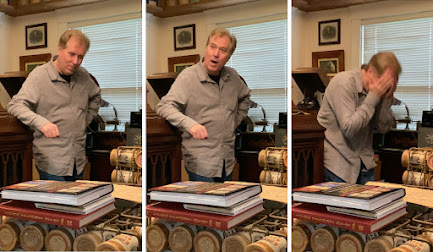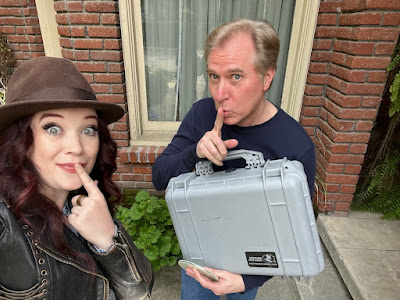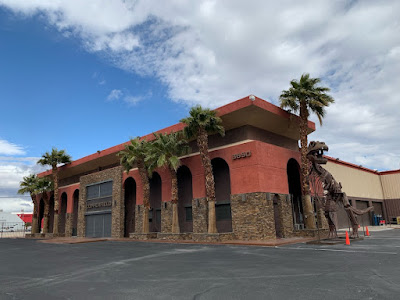This is news that I've long dreamed of being able to report. This may be the biggest news I've ever reported here on WILD ABOUT HARRY. Little did I dream that I would play a role in this moment of Houdini history, but a role I did play! But to share this news right, I need to tell the whole story.
One of the great treasures inside David Copperfield's International Museum and Library of the Conjuring Arts in Las Vegas are the original wax cylinders containing the only known recordings of Houdini's voice. These were discovered in 1970, and only two of the three Houdini cylinders were ever transferred to a playable media. (Only a short clip has ever been released.) The cylinder said to contain Houdini and his sister Gladys reading poetry written by their father was never transferred and has not been heard since 1970. There are also five other cylinders in the collection with no record of what's on them. So there's still a lot of mystery surrounding these cylinders.
For the past two weeks I've been doing work and research inside the museum. I shared some of my adventures here. But I was keeping a secret this whole time. Mike Caveney was also at the museum. Years ago Mike and I pitched David on the idea of making new digital transfers of all the wax cylinders. The purpose was to finally hear the fabled poetry cylinder, document what's on the mystery cylinders, and digitally preserve all the recordings for the future. David tasked us with investigating how this could be done safely.
It's been a long journey, years in fact, but all roads lead to Dr. Michael Khanchalian, aka "The Cylinder Doctor," who just happens to live 20 minutes from Mike. Not only can Michael repair damaged cylinders, but he has developed a player that can safely play old recordings. He was clearly the man for the job. So we once again pitched the idea to David.
Any reluctance on David's part was understandable. He has the original cylinders and the original tape transfers from 1970 (which, ironically, may no longer be playable), so why risk damaging the cylinders or discovering they had gone bad or, worse, that some slippery collector in the 1970s had pulled a switcheroo and he actually owned nothing. The value of these cylinders could be wiped out entirely. But David Copperfield is dedicated to preserving magic history, and if there was a chance of capturing a new piece of Houdini's voice, he would take the risk. He gave us the go-ahead and trusted us to get the job done.
Lifting the heavy glass off the display case in the museum to retrieve the cylinders was pretty nerve-wracking. And it was about to get worse. Mike had left the museum by the time all the arrangements had been made, so it fell to me to bring the cylinders to Los Angeles. Without revealing what I was doing to anyone besides those in the museum, I loaded all eight cylinders into my car and made the trek back to LA, battling a three-hour traffic jam and two hellacious downpours along the way. But I made it!
The next day (March 16, 2023) Mike and I arrived at Michael Khanchalian's beautiful home. He has an amazing collection of players and cylinders and is clearly an expert and enthusiast in this field. "He's the John Cox of wax cylinders," joked Mike. After a fabulous tour of his collection, we got down to work in his "lab."
The first three cylinders, which had come from David's vault and were labeled as containing Houdini's voice, did not contain Houdini's voice. Michael knew this instantly as he could tell they were commercial recordings and not the type of "blank" cylinders one would use for recording. Instead what we heard were vaudevillians Will Oakland ("When You and I Were Young, Maggie"), Billy Murray & Ada Jones ("Whistling Coquette") and a musical march (Queen of Sheeba). It was fun to hear these sounds from the past, but it was a little disconcerting, and the switcheroo theory was dancing in my head. But we still had five cylinders to go.
The cylinder labeled "Pa's Poems" (in Houdini's handwriting) was up next. Michael was encouraged by what he saw. At least this was the correct type of "blank" cylinder. This was the moment of truth. Houdini history was about to be made, for better or worse.
Michael slid the cylinder on his player, carefully calibrated the needle, hit the record button (we were making direct transfers to CD, no computers or hard drives involved), and lowered the needle. Then this happened.
Houdini's powerful voice boomed out over the room in a recording that had not been heard in 53 years. He introduces "an original German recitation" of poetry written by his father, "Reverend Doctor Mayer Samuel Weiss," to be spoken by his sister, "C. Gladys Weiss." There is a fantastic candid moment when Houdini is about to state his father's birthday and he has to ask Gladys, "What was the year?" It's very faint, but it's there, and we all looked at each other in delighted disbelief at what we had just heard.
Gladys then recites the poem in German. Gladys was blind, so she's doing this from memory. As Houdini says on the recording, the poem was "taught to her" by their father. I believe she makes a mistake and starts over after a small gap in the recording. Houdini then comes back on and says he will repeat the poem "in case you did not understand it." This seems to be his true speaking voice and not the "presentational" voice he uses on the other recordings. He then proceeds to recite the poem also in German. He speaks faster and, to my ear, more confidently in German, with great flair and rolling R's. Gladys signs off with the date, October 30, 1914, which is a day after the other recordings were made. The fact that this recording was made on a different day has never been documented.
Next up were the two full recordings of Houdini's Water Torture Cell patter. As with the poetry cylinder, each of these run just over four minutes. The quality of these transfers is much clearer than what exists currently. For years I believed Houdini says "I, Houdini" as his sign off. I've been wrong. "Harry Houdini" is now sparkling clear. There was also a big surprise waiting at the end of the first speech. After Houdini signs off, the cylinder seems to end. But then Gladys comes back on and "certifies" that she heard her brother "make this record" on October 29, 1914. This certification was never transferred in 1970 nor have I ever seen any mention of it. It's possible it was missed or the machine they used couldn't pick it up.
Speaking of the machine(s) from the 1970s, our expert Michael said he was amazed the recordings weren't destroyed back then, as you can't play these Edison Blanks on a regular machine. They are much softer and the weight of the needle can wipe them clean. Several times he said it was miraculous that the recordings survive and in such great fidelity.
The final two cylinders were commercial recordings of German songs. It was still exciting to hear these as all the cylinders belonged to Houdini and it's wild to hear the music he played at home for pleasure.
Over the next few days I prepared notes and transcriptions of all the cylinders and reunited them with their correct cases. I was helped in this by magician Jessica Jane Peterson who became the fourth lucky person to hear the poetry recording.
I then drove the cylinders back to Las Vegas and played the new recordings for David. He was thrilled by what he heard. He instantly picked up on all the same moments that had so excited us in LA, especially the moment when we hear Houdini's more natural speaking voice. Even before the recordings ended he was working on the next steps. Audio work will be done to clean up the recordings and the German will be translated. It was mission accomplished and everyone was delighted and relieved!
I took myself out to dinner that night and thought about what had happened. Not only had I finally heard the "Pa's Poems" cylinder, but I now understood it was always the most precious and personal recording of them all. Houdini loved and and honored his father and you can hear that. He loved his sister and you can hear that. The family language was German and you hear that. If Houdini ever came back, this would be the cylinder he would want to hear. Preserving it was more important than I ever understood. I felt like I had done a service for both Houdini and David Copperfield, and I was overwhelmed with gratitude at the amount of trust that had been placed in me.
I then sent David a text with one last request. Could I share this momentous news? His response came back quickly: "Sure."
As I said, David didn't need to do this. This headline could have easily read, "The Houdini wax cylinders are no more." But this is what makes David Copperfield a titan of magic. He took the risk, extended extraordinary trust, and now deserves the credit for saving this important piece of Houdini history. Maybe even the most important piece. When and where the general public might hear these I can't say. But the fact that we can now hear them was the purpose of this incredible journey.
Thanks to David Copperfield, Mike Caveney, Michael Khanchalian, Jessica Jane Peterson, Glenda Wellendorf, and everyone who helped bring Houdini (and Gladys Weiss) back to life.
Want more? You can view additional images from this adventure as a "Scholar" member of my Patreon by clicking below.





































